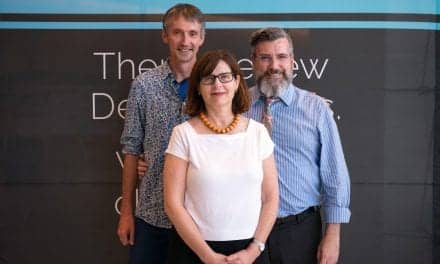By linking human population studies with experiments in cell and animal models, researchers have provided evidence that complex mixtures of endocrine disrupting chemicals impact children’s brain development and language acquisition. With their novel approach, the scientists show that up to 54% of pregnant women were exposed to experimentally defined levels of concern. An article detailing the research appears on the Uppsala University website.
While current risk assessment tackles chemicals one at a time, the new findings show the need to take mixtures into account for future risk assessment approaches.
There is increasing evidence that environmental chemicals to which we are continuously exposed can have endocrine disrupting properties and can thus be dangerous to human and animal health and development. Every year sees the release of a huge number of new compounds as part of the market authorization and production processes of a vast range of goods, chiefly but not only plastic derivatives, that enter the human body from several sources, including water, food, and air. While exposure levels for individual chemicals are often below existing limit values, exposure to the same chemicals in complex mixtures can still impact human health. Yet all existing risk assessments, and thus established limit values, are based on chemicals being examined one at a time. There was thus a strong need to test whether an alternative strategy would be possible, in which the actual mixtures measured in real life exposures could be tested as such in both the epidemiological and experimental setting. The EU-funded EDC-MixRisk project set out to tackle this unmet need.
“The uniqueness of this comprehensive project is that we have linked population data with experimental studies, and then used this information to develop new methods for risk assessment of chemical mixtures,” said Carl-Gustaf Bornehag, professor at Karlstad University, project manager of the SELMA study, and responsible for the epidemiological part of EDC-MixRisk.
The study was conducted in three steps:
- Firstly, a mixture of chemicals in the blood and urine of pregnant women was identified in the Swedish pregnancy cohort SELMA (see description at end of article for more details), associated with delayed language development in children at 30 months. This critical mixture included a number of phthalates, bisphenol A, and perfluorinated chemicals.
- Secondly, experimental studies uncovered the molecular targets through which human-relevant levels of this mixture disrupted the regulation of endocrine circuits and of genes involved in autism and intellectual disability.
- Thirdly, the findings from the experimental studies were used to develop new principles for risk assessment of this mixture.
“It is striking that the findings in the experimental systems well reflected what we found in the epidemiological part, and that the effects could be demonstrated at normal exposure levels for humans,” said Joëlle Rüegg, professor of environmental toxicology at Uppsala University and vice coordinator of EDC-MixRisk.
“Human brain organoids (advanced in vitro cultures that reproduce salient aspects of human brain development) afforded, for the first time, the opportunity to directly probe the molecular effects of this mixture on human brain tissue at stages matching those measured during pregnancy. Alongside other experimental systems and computational methods, we found that the mixture disrupts the regulation of genes linked to autism (one of whose hallmarks is language impairment), hinders the differentiation of neurons and alters thyroid hormone function in neural tissue,” said Giuseppe Testa, principal investigator of the EDC-MixRisk responsible for the human experimental modeling, professor of molecular biology at the University of Milan, head of the Neurogenomics Research Centre at Human Technopole, and group leader at the European Institute of Oncology.
“One of the key hormonal pathways affected was thyroid hormone. Optimal levels of maternal thyroid hormone are needed in early pregnancy for brain growth and development, so it’s not surprising that there is an association with language delay as a function of prenatal exposure,” said Barbara Demeneix, professor of physiology and endocrinology at the Natural History Museum in Paris and involved in the mechanistic, in vivo, studies.
By linking different scientific methods in this way, the researchers were able to show that 54% of children included in the SELMA study were at risk of delayed language development (at age 30 months) as they were prenatally exposed to a mixture of chemicals at levels that were above the levels predicted to impact neurodevelopment. This risk did not become apparent when the current limit values for individual chemicals were used.
The study was conducted in a collaboration among universities and research centers from Sweden (Uppsala University, Karlstad University, University of Gothenburg, Karolinska Institutet, Lund University, Stockholm University, Örebro University), Italy (University of Milan, European Institute of Oncology, and Human Technopole), France (CNRS/Muséum d’histoire naturelle), Finland (Finnish Institute for Health and Welfare (THL)), Germany (University of Leipzig), Greece (National and Kapodistrian University of Athens), and the US (Icahn School of Medicine at Mount Sinai, New York).
The SELMA study is conducted at Karlstad University, Sweden, and follows approximately 2,000 mother–child pairs from early pregnancy over childbirth and up to the child reaching school age. The overall aim is to investigate the impact of exposure to suspected or proven endocrine disrupting chemicals during early pregnancy on the child’s health and development later in life. The study has shown a connection between mixtures of different chemicals and the child’s gender development, respiratory problems, cognitive development, and growth during childhood.
Original Paper: Caporale N, Leemans M, Birgersson L, et al. From cohorts to molecules: Adverse impacts of endocrine disrupting mixtures. Science. 2022;375(6582).
Source: Uppsala University, Science






